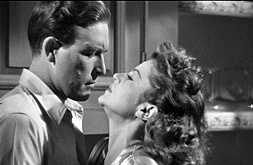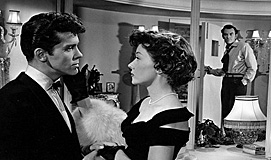Fri 3 Mar 2017
MIKE NEVINS on FRENZY (1972) and LES INCONNUS DANS LA MAISON (1941).
Posted by Steve under Columns , Crime Films , Reviews[6] Comments
by Francis M. Nevins
Considering that I was an inch from death last month, perhaps a March column is asking too much of myself. We shall see. I suspect this one is going to be a bit skimpy.
On the 6th of February, at age 91, Alec McCowen died. He was one of the most revered English actors, having appeared in several Shakespeare productions, including ROMEO AND JULIET and KING LEAR, and a number of 20th-century classics like PYGMALION and EQUUS.
He also had roles in 30-odd movies, of which the best known is probably FRENZY (1972). Who can forget his performance in that last of Hitchcock’s great films? As the harried Scotland Yard inspector, a bangers-and-mash man if ever there was one, who comes home after a hard day trying to track down a serial rapist and killer only to find his wife (Vivien Merchant) getting ready to serve him a tasty dinner of sautéed lovebirds’ wings or something of the sort, he’s unforgettable.
The last time I saw FRENZY was when it came out 45 years ago, but it’s still green in my memory. Shot in London, it tells the story of down-and-out ex-RAF pilot Richard Blaney (Jon Finch), who becomes the prime suspect in a series of brutal rape-murders and goes on the run. The real criminal is Robert Rusk (Barry Foster), a Covent Garden fruit-and-vegetable merchant as was Hitchcock’s father, and much of the location shooting takes place in the neighborhood the director knew as a boy.
For a time the fugitive Blaney is protected by fellow RAF veterans — which would have made more sense if the picture’s events had taken place immediately after World War II, when the surviving Battle of Britain pilots were national heroes — but eventually he’s caught by Inspector Oxford (our man McCowen) and locked up. Knowing by then that Rusk is the real murderer, Blaney escapes and sets out for revenge.
I’d be a toad if I gave away more of the plot, which is summarized on several websites devoted to the picture. Among all the Hitchcock films after PSYCHO (1960), FRENZY stands out as by far the most suspenseful.
So far this is indeed a mini-column, but a recent phone conversation with a friend who teaches literature and film allows me to extend it. For a forthcoming book on film noir, my friend has agreed to write a chapter on the French contributions to the genre during the Nazi occupation. This is a subject on which I’m woefully ignorant but I do know that one of the titles that falls within this category is LES INCONNUS DANS LA MAISON (1941), which was based on Georges Simenon’s 1940 novel of the same name, translated into English after the war as STRANGERS IN THE HOUSE (1954).
In both novel and film the main character is Hector Loursat, a gross and unkempt lawyer — his bearishness signaled, at least for those who know a little French, by his name — who has retreated into an alcoholic shell after his wife left him. When a small-time gangster is discovered murdered in the huge Loursat house, our protagonist finds himself forced to defend his daughter’s lover, who’s accused of the crime.
Unusually for Simenon, a good bit of the novel takes place in court, and the legal procedure will cause readers familiar with the English or American systems to throw up their hands more than once. (For example, the defense counsel cannot question witnesses directly but must ask the judge to repeat each question to whoever is on the stand.) Anyone who expects the kind of forensic fireworks associated with Perry Mason novels is likely to find the book frustrating, but on its own terms it’s widely considered one of the best of Simenon’s stand-alone crime novels and I would have to agree with this verdict.
How close the Occupation-era movie came to its source is unclear, although from what I’ve found on the Web there seem to be considerable differences. The film climaxes with a passionate speech by Loursat (Raimu), indicting the older generation for the peccadilloes of the young, which has no counterpart in Simenon. (This speech can be accessed on YouTube, but it’s in French.) To discover any other differences I’ll have to wait for my friend’s essay.
To complete my account of Simenon’s novel [WARNING] I have no choice but to reveal the real killer. It turns out to be a young delinquent called Justin Luska, whose motivation for the crime is clear as mud. He’s described as the “son of a tradesman,…[who] because of his red hair, his name, his real first name, Ephraim, the Eastern origin of his father, was the object of ridicule of his schoolmates….People said that he smelled, like his father’s shop….â€
When the father enters the courtroom late in the proceedings, Simenon tells us that he looked like “a man belonging to that race of humans you find sleeping in the corridors of night trains, sitting patiently in police stations, trying desperately to explain themselves in an impossible language, the sort that is always questioned at frontiers….[D]idn’t the fact that his coat smelled bad cause others to step aside?….He was dark and oily, almost flabby….â€
The word Jew is never mentioned, at least not in the English translation that postdates WWII and the Holocaust, but the Luskas père et fils remind us irresistibly of those scruffy East European Jews who to Simenon’s discredit pockmark his novels of the 1930s.
If they are clearly identified as Jews in the original French, this wouldn’t be the first time a translator refused to be true to Simenon’s text. As I discussed in an earlier column, Anthony Boucher did precisely the same thing when during the war years he translated a Simenon short story with a Jewish villain for EQMM. Sometimes it’s better to be unfaithful. Indeed, when the 1941 movie was re-released after the war, the soundtrack was tinkered with so that Luska’s first name morphs from Ephraim to the clearly un-Jewish Amédée. In the France of the immediate postwar years, even the appearance of anti-Semitism was taboo.
Ah! Now we have a column of respectable dimensions. Perhaps I’ll do better, or at least longer, next month.


